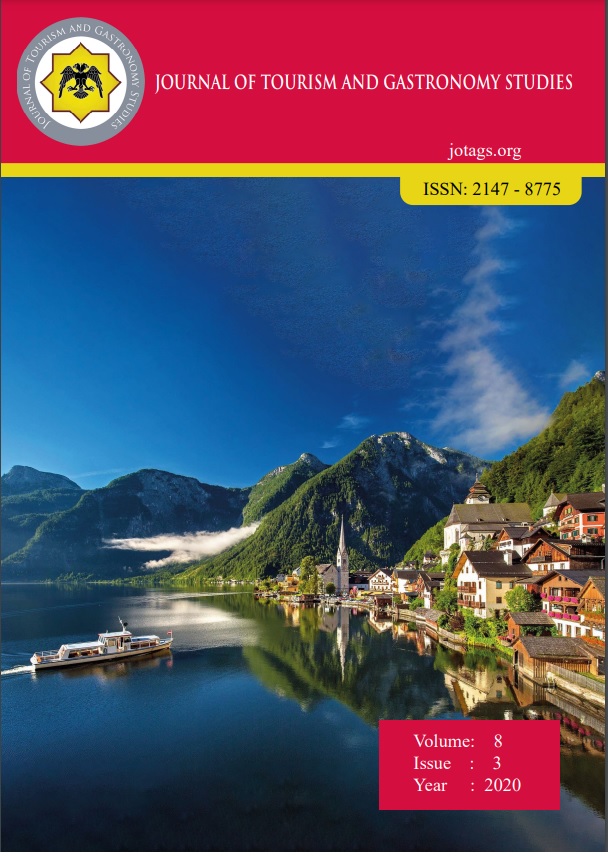Çay Turizmi: Doğu Karadeniz Bölgesinde Uygulanabilirliği Üzerine Değerlendirme (Tea Tourism: Evaluation on Applicability in the Eastern Black Sea Region)
DOI:
https://doi.org/10.21325/jotags.2020.643Keywords:
Tea, Culture, TourismAbstract
Tourists want to visit the historical, natural beauties in the destination they visit as well as experience local tastes with historical and cultural values and to learn the story of these local tastes. Gastronomic flavors and culinary cultures of the region for tourists are also elements of destination attractions. Turkish tea culture and consumption, which possess sociocultural features, can be marketed as a tourist product. Tea is not only an agricultural and economic product in our country, but also a cultural indicator. Using tea as a touristic product will be effective in terms of introducing Turkish tea in the world, as well as creating a new touristic trend and will provide an economic recovery in the regions where tea is grown. Tea tourism is a subject that is handled within the framework of rural and gastronomy tourism in alternative tourism types. In this study, the potential of Turkey in tea tourism will be discussed. Document review method was used in this research
References
Aslam, M.S.M., & Jolliffe, L. (2015). Repurposing colonial tea heritage through historic lodging. Journal of Heritage Tourism, 10(2), 111-128.
Cheng, S., Xu, F., Zhang, J., & Zhang, Y. (2010). Tourists' attitudes toward tea tourism: a case study in Xinyang, China. Journal of Travel & Tourism Marketing, 27(2), 211-220.
Cheng, S., Hu, J., Fox, D., & Zhang, Y. (2012). Tea tourism development in Xinyang, China: stakeholders’ view. Tourism Management Perspectives, 2 -3,28-34.
Datta, C. (2018) Future prospective of tea-tourism along with existing forest-tourism in Duars, West Bengal, India. Asian Review of Social Sciences, 7 (2), 33-36.
Demirçivi, M.B.(2018). Ekonomik bir değer olarak çay, Altaş. A. (Ed.) Tüm yönleriyle çay ve çay turizmi içinde (ss. 130-141 ). Ankara: Detay Yayıncılık.
Doğan, S. (2018). Çayın tanımı ve tarihçesi. Altaş, A. (Ed.), Tüm yönleriyle çay ve çay turizmi içinde (ss. 2-8). Ankara: Detay Yayıncılık.
Eröz, S., & Bozok, D. (2018). Çay turizmi ve Rize ili potansiyeli. Üçüncü Sektör Sosyal Ekonomi, 53 (3), 1159-1176.
Fernando, P.I.N., Kumari, K.W.S.N., & Rajapaksha, R.M.P. D.K. (2017). Destination marketing to promote tea tourism socio-economic approach on community Development. International Review of Management and Business Research, 6(1), 68-75.
Forster, N. (1995). The analysis of company documentation. In Casell, C. and Symon, G. (Eds.). Qualitative methods in organizational research: A Practical Guide, London: Sage.
Geoffrey, S., Wall, Y., & Wang, Y. (2019). Integrating tea and tourism: a sustainable livelihoods approach. Journal of Sustainable Tourism, 27 (10), 1591-1608.
Hajiboland, R. (2017). Environmental and nutritional requirements for tea cultivation, Folia Hort. 29(2), 199-220.
Jolliffe, L. (2007). Tea and tourism: Tourists, traditions and transformations. Clevedon, UK: Channel View Publications.
Jolliffe, L., & Aslam, M.S.M. (2009). Tea heritage tourism: evidence from Sri Lanka. Journal of Heritage Tourism, 4(4), 331-344.
Karaşah, B. (2019). Kırsal Turizm kapsamında çay turizminin değerlendirilmesi: Artvin örneği. Uluslararası Sosyal Araştırmalar Dergisi, 38 (12), 1169-1175.
Kaygısız, N.(2018). Çay Turizmi. Altaş, A. (Ed.) Tüm yönleriyle çay ve çay turizmi içinde (ss. 75-84 ). Ankara: Detay Yayıncılık.
Özçırak, M. (2019). Çay sektörü ve Türkiye ekonomisi (Yüksek Lisans Tezi). Bursa Uludağ Üniversitesi Sosyal Bilimler Enstitüsü, Bursa.
Özyazıcı, M. A., Sağlam, M., Dengiz, O., & Erkoçak, A. (2014). Çay tarımı yapılan topraklara yönelik faktör analizi ve jeoistatistik uygulamaları: Rize ili örneği. Toprak Su Dergisi, 3 (1), 22-23.
Oğuz, T. (2020). Kırsal Turizm. Olcay, A. (Ed.) Alternatif turizm içinde (ss.303-324). Ankara: Detay Yayıncılık
Su, M. M., Wall, G., & Wang, Y. (2019). Integrating tea and tourism: A sustainable livelihoods approach. Journal of Sustainable Tourism, 27(10), 1591-1608.
Sharma, S.K., & Bhowmick, S. (2016). Tea tourism in Darjeelıng. IJARIIE, 2(4), 1120-122.
Sultana, S., & Khan, S. R. (2018) Factors determining tourism: A framework to promote tea tourism destination in Chittagong. Global Journal of Management and Business Research, 18(1), 2249-4588.
Çay Sektörü Raporu (2015). http://www.caykur.gov.tr/CMS/Design/Sources/Dosya/Yayinlar/104.pdf 06.07.2020 tarihinde alınmıştır.
Çay Sektörü Raporu (2019).
http://www.caykur.gov.tr/Pages/Yayinlar/YayinDetay.aspx?ItemType=5&ItemId=721 06.07.2020 tarihinde alınmıştır.
Recep Tayyip Erdoğan Üniversitesi Çay İhtisaslaşma Koordinatörlüğü Çay Çalıştayı (2019). Çalıştay Sonuç Raporu, http://cayihtisas.erdogan.edu.tr/Files/ckFiles/cayihtisas-erdogan-edu tr/%C3%87AY%20%C3%87ALI%C5%9ETAYI%20K%C4%B0TAP%C3%87I%C4%9EI.pdf 08.07.2020 tarihinde alınmıştır.
Rize Çay Araştırma ve Uygulama Merkezi’nin Kurulması Teknik Yardım Projesi (2008). Çay turizmi stratejisinin ve eylem planının geliştirilmesi, https://www.rtb.org.tr/uploads/files/791-
Downloads
Published
How to Cite
Issue
Section
License
Copyright (c) 2023 Journal of Tourism & Gastronomy Studies

This work is licensed under a Creative Commons Attribution-NonCommercial 4.0 International License.








